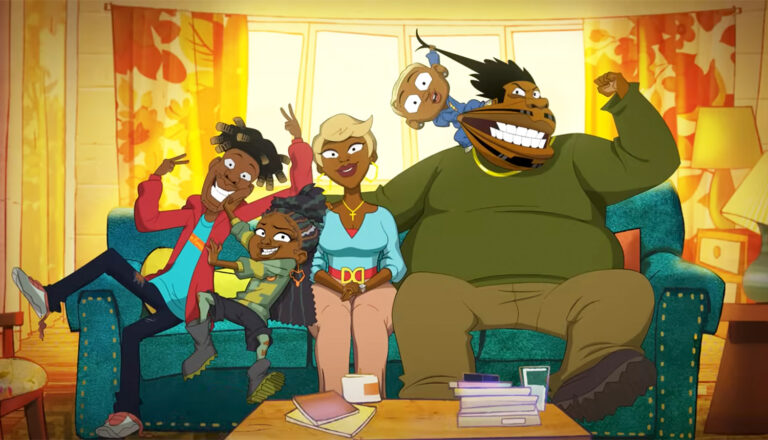
Good Times
Netflix takes a classic sitcom, Good Times, and turns it into a vulgar, violent, sexually-charged TV-MA show.

Dr. Finnix only wanted to help.
He’d been doing just that for decades in this tiny Virginia town. He’d make house calls. He’d serve up a little advice at church potlucks. These folks worked hard for what little they had, pulling coal out of the mountain to put meat on the table. Giving his patients a little extra care was the least he could do.
So when he learned about a new “miracle drug” in 1996—a pill that could ease the chronic pain that his patients often dealt with—he was thrilled. An opioid that was effective and non-addictive? Almost too good to be true.
Turns out, it was.
Dopesick traces the drug back to its birth 10 years before, when Richard Sackler pitches the idea to his father and uncles. He argues that the Sacklers—one of the wealthiest families in America and owners of Purdue Pharma—should do what they can to relieve chronic pain. Oh, and by the way, the patent for Purdue’s most popular, most lucrative drug is about to expire, too. Time to find a new cash cow and fix a grievous problem at the same time.
Ten years later, OxyContin is initially rolled out to a handful of communities in the U.S.—largely rural, hardscrabble centers where people worked long, worked hard and were often injured on the job. The drug is pushed by a legion of Purdue salespeople who come armed with psychologial profiles of the doctors they’re selling to and a bevy of buzzy phrases: time-release system. FDA approved. Less than 1% of users get addicted.
But by the turn of the Millennium, a few are beginning to wonder just how accurate that 1% figure is. Bridget Meyer, who works for the Drug Enforcement Administration, discovers the drug during a routine 1999 cocaine bust: dealers are peddling these pills along with the powder. In 2002, two Virginia lawyers discover that almost every case they prosecute these days—from drug sales to armed robbery—has some connection with Oxy. “Our community is ground zero to a growing national catastrophe,” one says.
But in 1996, Dr. Finnix had no idea of all that. He listened to the sales pitch, the promises of rock-bottom addiction rates, the assurances for a pain-free life. And so he began to write prescriptions for OxyContin. Again. And again.
Hulu’s Dopesick (based on a non-fiction book of the same name by Beth Macy) hops through the years like a frog on lilypads—jumping backward and forward with practiced conviction. It introduces us to the family that funded OxyContin’s creation, the salespeople who pushed it, the doctors who prescribed it and the people who, finally, questioned it.
But the drama focuses its strongest lens on the people who used it—forcing us to confront the real toll of the opioid epidemic that, by 2002, was off and running.
This eight-part miniseries, anchored by a strong cast that’s led by Oscar-winning actor Michael Keaton, is gripping, sobering and deeply convicting. It takes a difficult issue and turns it into an engrossing, surprisingly watchable story. I’d not be at all surprised to see this up for awards down the road.
But Plugged In probably won’t be giving it any.
I say this with regret. The people we meet here feel real and alive, and Dopesick shows that many touched by the opioid crisis were folks of deep faith. The creators take some care to not turn these Christians into caricatures, either.
But the show’s three-dimensional characters also represent a diversity of viewpoints and a range of lifestyles. The first person that Dr. Finnix prescribes OxyContin to is a closeted lesbian coalminer who wants to keep working so she can ultimately leave town.
In the very first episode, we see the miner and her lover in bed in an obvious moment of intimacy. Sexual content makes plenty of other appearances here, from randy sales people and ribald jokes to addicts looking to make money in the world’s so-called oldest profession. While the miniseries succeeds in getting under your skin, it perhaps shows more than we’d like.
Language fouls many an episode. And, of course, the whole miniseries is predicated on drug use and abuse, so that element is inherently inescapable.
Dopesick isn’t meant for kids, obviously. This is an adult drama with mature concerns. It does what well-crafted, issues-oriented dramas are supposed to do: It forces us to hear sometimes ugly stories in a quest to find, perhaps, an ugly truth.
Dopesick shows us that ugliness. And for many, it might be best to turn away.
Five different years are represented here. In 1986, Rich Sackler pitches the idea of a time-released opioid to relatives, who own a pharmaceutical company. In 1996, the drug begins making its appearance, and Dr. Finnix prescribes them to Betsy Mallum, a fourth-generation coalminer who needs to get back underground quickly. In 1999, DEA employee Bridget Meyer begins to investigate the drug and its impact, and in 2002 a pair of Virginia prosecutors open their own investigation. Finally, in 2006, experts—including Dr. Finnix—testify to the impact of OxyContin on their communities. Finnix pauses and thinks about those he prescribed the drug to. “I can’t believe how many of them are dead now,” he says.
Betsy’s parents are deeply religious, and we see them pray on a few occasions—once for God to take away Betsy’s pain (as, in another room, the doctor gives her her first Oxycontin pill). Betsy’s father (who works with her in the coalmine) reprimands a fellow miner (Grace) to watch her language around his daughter—not realizing that Betsy and Grace are lovers.
They know Grace is a lesbian, though, and Betsy’s mother says—rather kindly—that she’ll pray for Grace. (Betsy and Grace joke about that promise later.) A lawyer also prays with his family around a dinner table, and Dr. Finnix visits a church potluck to diagnose and help with various ailments.
Grace and Betsy have a sexual encounter. Though both are clothed and covered in bedsheets, it’s obvious what’s going on. (The two kiss in a bathroom, too.) A salesman tries to pick up a female associate, but she asks if he’s gay and makes pejorative comments about his anatomy. A prostitute trying to earn money for her opioid addiction tells a prospective “John” what she charges for various sexual acts. A 14-year-old girl cries to Finnix because she hasn’t gotten her period yet. Grace banters with fellow minors over her sexual preferences. An old woman recalls working with a lesbian once.
Sackler family members and their lawyers drink champagne at a pharmaceutical board meeting. There’s a verbal reference to drinking whiskey. People joke about obtaining Vicodin and other drugs. Women—dressed only in their underwear—work at a cocaine refinery. We hear about how one member of the Sackler family is doing his best to dodge taxes. Betsy slams her back into a protruding corner and falls down, obviously hurt. (We later see a terrible bruise a couple of times on her bare back.)
Characters say the f-word seven times and the s-word once. We also hear “b–ch,” “h—” and “f-g.”


Paul Asay has been part of the Plugged In staff since 2007, watching and reviewing roughly 15 quintillion movies and television shows. He’s written for a number of other publications, too, including Time, The Washington Post and Christianity Today. The author of several books, Paul loves to find spirituality in unexpected places, including popular entertainment, and he loves all things superhero. His vices include James Bond films, Mountain Dew and terrible B-grade movies. He’s married, has two children and a neurotic dog, runs marathons on occasion and hopes to someday own his own tuxedo. Feel free to follow him on Twitter @AsayPaul.

Netflix takes a classic sitcom, Good Times, and turns it into a vulgar, violent, sexually-charged TV-MA show.

While its protagonist might live a nuanced life, The Sympathizer’s problematic content can’t be described the same way.

Say hola once again to the iconic explorer in this faithful reboot of the children’s series.

Based on a popular video game, Ark: The Animated Series features hungry dinosaurs, bloodthirsty people and plenty of problems.